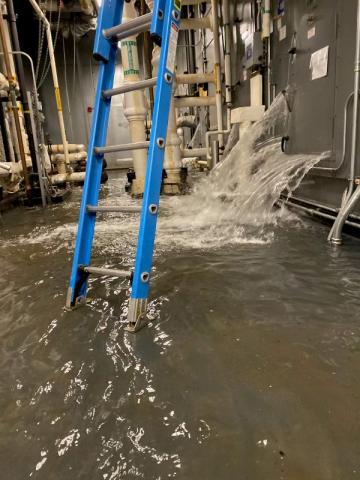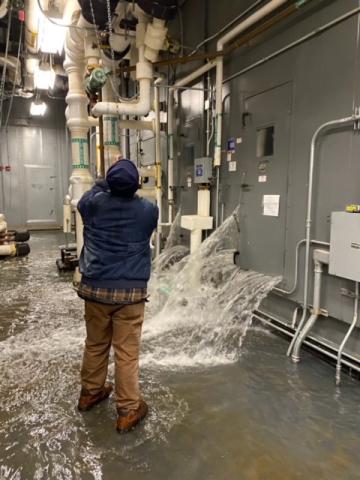Extreme-Weather Consequences
Multiple Buildings on Bethesda Campus Still Recovering from Flooding

Photo: Michelle Kilosky/NIH ORF
During the recent heavy rains and cold snap, NIH’s Bethesda campus suffered water damage from floods in multiple buildings that ranged from minor to catastrophic. Even a minor flood or leak can have significant consequences.
Buildings that sustained damage included the D corridor in Bldg. 10 (floors 5 down to the B1 level), along with Bldgs. 14, 21, 31 and 49. More significantly, Bldg. 50 suffered numerous leaks of the perimeter heating system, affecting more than 47,000 square feet of space. There also were 11 water main ruptures throughout the campus.
Most significantly, the flooding in the Bldg. 35 complex (35 and 35A, or Porter Neuroscience Research Center) was so bad that the building had to temporarily close for safety reasons. In response, multiple Office of Research Facilities (ORF) and Office of Research Services (ORS) divisions and numerous lab managers and other staff worked together to help re-open the complex. Wings B and C, however, are still closed.

Photo: Michelle Kilosky/NIH ORF
Two primary incidents took place in Bldgs. 35 and 35A:
The first event happened on Dec. 24 when reheat coils started rupturing all over the B and C wings of Bldg. 35. What was thought to be about 20 ruptures turned out to be 99 failures or leaks caused by an abrupt pressure spike in the low-pressure water heating system.
The second incident occurred on Dec. 25 when a chilled water coil in an air handling unit ruptured and associated isolation valves failed, releasing approximately 90,000 gallons of chilled water. This event affected labs in Bldg. 35A in pod D from floors 3 through the basement.
Some spaces have reopened, but many areas remained closed as cleanup continues.—Gregar Odegaarden, ORF/ORS
